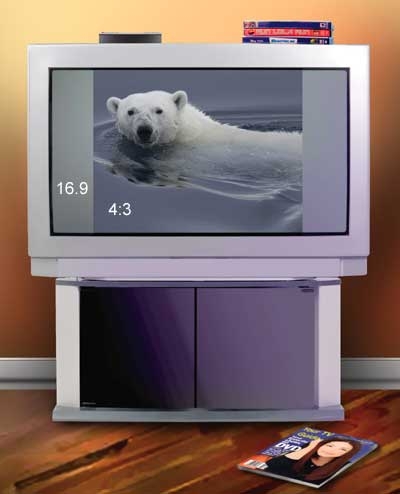Back to Basics: How to Set Up Your new HDTV Page 3
The Finishing TouchesReady to sit back and watch your favorite team in all its high-def glory? Not so fast. Like all TVs, your new HDTV will require a first-time setup, using the remote control and onscreen menus, to set audio output options and other functions like channel scan and off-air antenna or cable tuning.  Most HDTVs have a widescreen 16:9 aspect ratio. To accomodate traditional 4:3 aspect ratio broadcasts, most models place gray bars to the sides of the image.
Most HDTVs have a widescreen 16:9 aspect ratio. To accomodate traditional 4:3 aspect ratio broadcasts, most models place gray bars to the sides of the image.
It will also need to be calibrated to perform at its best. You can use DVDs like the Sound & Vision Home Theater Tune-Up, the Avia Guide to Home Theater, and Digital Video Essentials for this. I like the Home Theater Tune-Up disc (okay, I might be a little biased) because it's easy to use and contains essential test patterns and step-by-step instructions for adjusting color, brightness, contrast, and other critical picture settings. It also takes you through receiver and speaker setup and other necessities for getting peak performance from your entire home theater system.
Before settling into your favorite chair, there are a few other points to note. Make sure the aspect ratio of your DVD player and widescreen HDTV are both set to 16:9 (usually called "full mode" in the TV's setup menu) and not the squarish 4:3 aspect ratio, which is the typical default for DVD players. Otherwise, the set may stretch a 4:3 DVD image to fit the 16:9 screen - resulting in bloated bodies and egg-shaped wheels. This can also be a problem if you're using a progressive-scan player that doesn't have "aspect ratio control." The problem here is that some HDTVs "lock" into full mode when displaying a progressive-scan DVD. If you're watching a 4:3 program, it'll be stretched to fill the 16:9 screen, which looks pretty bad. But if your progressive-scan player has aspect ratio control, it will send the TV a properly formatted picture.
There are a number of options for HDTV recording. As noted, some high-def cable boxes and satellite receivers have a built-in hard disk for recording in high-def. HD tuners also send downconverted versions of high-def programs to their analog composite-/S-video and stereo audio outputs so you can make standard recordings on your VCR or DVD recorder.
Now you're ready to enjoy all the thrills and splendor of HDTV, experiencing favorite TV shows, sports, and movies as never before. In fact, after just a few minutes in front of your new high-def set, you'll know what millions of viewers already do - once you've seen HDTV, there's no turning back.
- Log in or register to post comments





























































